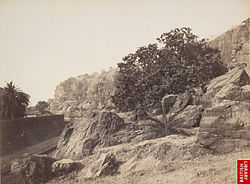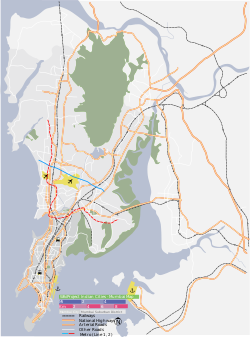Malabar Hill
| Malabar Hill | |
|---|---|
| Neighbourhood | |

Malabar Hill in the 1850s
|
|
| Coordinates: 18°57′00″N 72°47′42″E / 18.95°N 72.795°ECoordinates: 18°57′00″N 72°47′42″E / 18.95°N 72.795°E | |
| Country | India |
| State | Maharashtra |
| Metro | Mumbai |
| Languages | |
| • Official | Marathi |
| Time zone | IST (UTC+5:30) |
| PIN | 400006 |
| Area code(s) | 022 |
| Vehicle registration | MH 01 |
| Civic agency | BMC |
Malabar Hill (Marathi: मलबार हिल), a hillock in southern Mumbai, Maharashtra, India, is an upmarket VVIP residential area which has the Government Guest House Sahaydri, the Chief Minister of Maharashtra's Bungalow, official residences of VVIP state officials, famous Hanging Gardens, Jain Temple & Banganga Tank. The Malabar Hill district is notably the most exclusive residential area in Mumbai, and home to several business tycoons and film personalities. Iconic buildings like Everest Apartments, El-Cid, Silver Arch, Hanvant Bhavan, Anita, Blue Haven, Darshan, Sundatta Apartments, Ill Pallazo, Mayfair Gardens, Alankar, Benhur are known to be the most sought after private house pads for business czars with prices of apartments as high as Rs.1,35,000 per sq ft. (US$25000/m2), making it one of the most expensive neighborhoods to stay in the world. Notable residents include Adi Godrej, the Birla family, Shashi Ruia & family, Pallonji Mistry, Mahesh Jethmalani, the Jindal family, the Lal family among many more.
The seafarers from Konkan used to land at the extreme south end of the hill for a pilgrimage to the Walkeshwar Temple and the Banganga Tank. Many of them were part of the Maratha Navy were wrongly designated as "Pirates" from "Malabar". Hence the landing point became "Malabar Point" and eventually the hill became "Malabar Hill". The Brihanmumbai Municipal Corporation, has proposed to change the name of Malabar Hill, arguably the city's most exclusive residential enclave, to Ramnagari, in vain.
Malabar Hill is the location of the Walkeshwar Temple, founded by the Silhara kings. The original temple was destroyed by the Portuguese, but rebuilt again in 1715 by Rama Kamath, and by 1860, 10 to 20 other temples were built in the region.
...
Wikipedia

